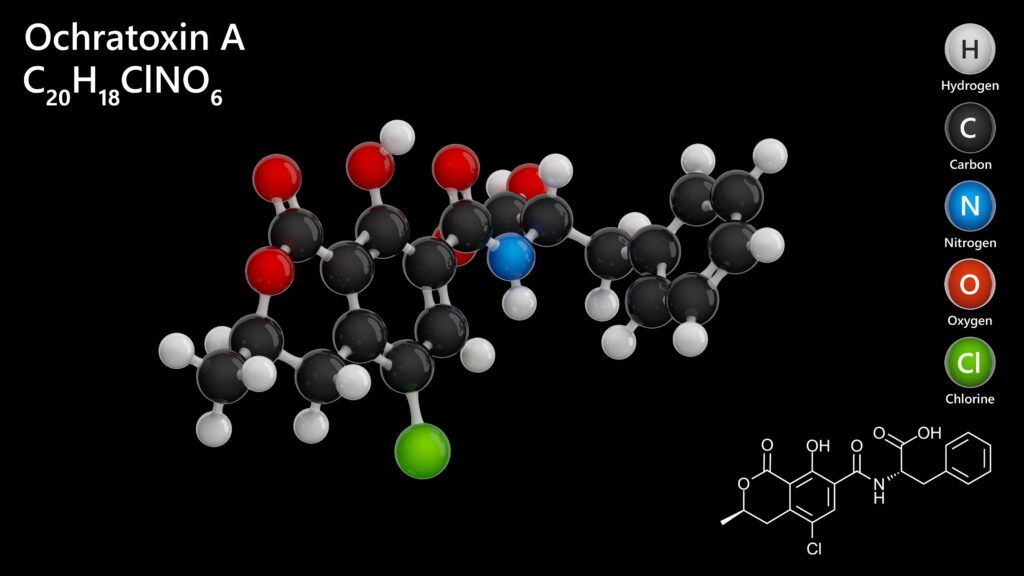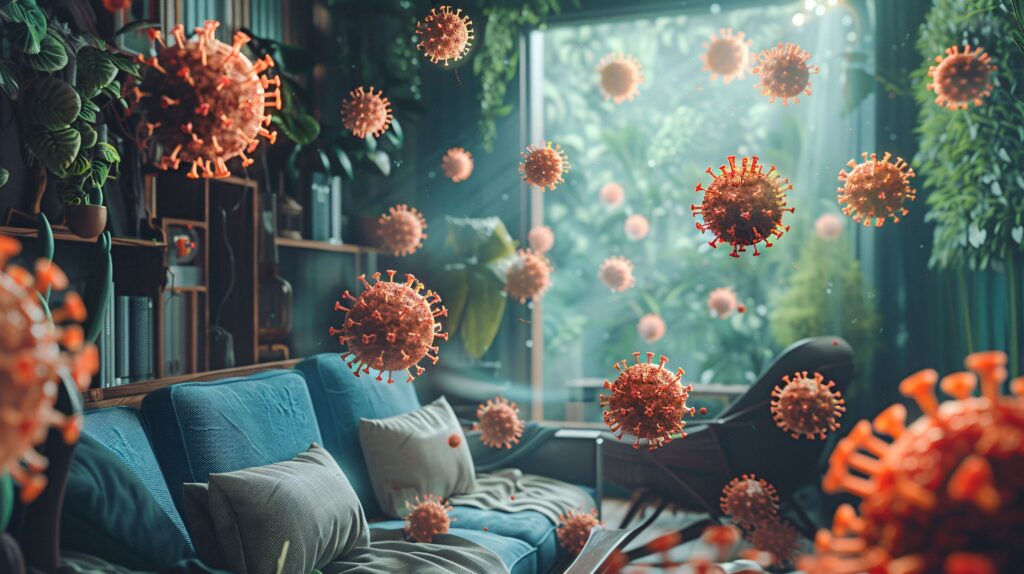What Are Mycotoxins?
Mycotoxins are toxic compounds produced by certain types of fungi. These fungi, commonly referred to as molds, can grow on a variety of surfaces, including food, agricultural products, and building materials, particularly in environments with high moisture levels. Mycotoxins can pose significant health risks when inhaled, ingested, or absorbed through the skin.
Among the many types of mycotoxins, ochratoxins are particularly noteworthy due to their prevalence and potential health impacts. Ochratoxin A (OTA), a subgroup of ochratoxins, is one of the most studied and concerning due to its toxic effects on humans and animals.
What Are Ochratoxins and Ochratoxin A?

Ochratoxins are a family of mycotoxins produced primarily by species of Aspergillus and Penicillium molds. These molds thrive in warm, humid conditions and are commonly found on improperly stored grains, nuts, coffee beans, dried fruits, and other food products. They can also grow in water-damaged buildings, contributing to indoor air quality issues.
Ochratoxin A, the most toxic member of this group, is known for its nephrotoxic (kidney-damaging) effects. Studies have also linked OTA to immunosuppression, neurotoxicity, and carcinogenicity. The toxin can accumulate in the human body, leading to chronic health problems with prolonged exposure.
The Connection Between Ochratoxins and Aspergillus Mold
While several mold species produce ochratoxins, Aspergillus ochraceus and Aspergillus carbonarius are primary culprits in generating OTA. These molds are often found in humid climates and can colonize a variety of substrates, including:
- Building materials in damp environments (e.g., drywall, wood, or insulation).
- Food products, especially cereals, legumes, and coffee stored improperly.
- Indoor environments with water damage, leaks, or high humidity levels.
The presence of Aspergillus molds indoors often indicates underlying moisture problems, making effective mold testing and remediation essential to reduce OTA exposure.

How Ochratoxin A Affects Human Health
OTA’s impact on health depends on the level and duration of exposure. Some of the key health risks include:
- Kidney Damage:
- OTA is nephrotoxic and can lead to chronic kidney disease.
- Immune Suppression:
- Prolonged exposure can weaken the immune system, making individuals more susceptible to infections.
- Carcinogenic Potential:
- The International Agency for Research on Cancer (IARC) classifies OTA as a possible human carcinogen.
- Neurotoxicity:
- Evidence suggests that OTA may contribute to neurodegenerative conditions, including Parkinson’s disease.
Individuals experiencing symptoms like chronic fatigue, respiratory problems, headaches, or unexplained health issues should consider testing for mycotoxins, especially if they’ve been exposed to damp or moldy environments.
Testing for Mycotoxins in the Body
If you suspect exposure to OTA or other mycotoxins, testing your body can provide crucial insights. The two most common methods are urine and blood tests:
1. Urine Mycotoxin Testing
Urine tests are a non-invasive and effective way to detect the presence of mycotoxins in the body. These tests measure the metabolites of mycotoxins, indicating both recent and ongoing exposure. Advantages of urine testing include:
- Ease of Collection: Simple sample collection makes it convenient.
- Broad Detection: Many labs test for multiple types of mycotoxins, including OTA.
- Sensitivity: Detects even low levels of exposure.
2. Blood Mycotoxin Testing
Blood tests can provide a more detailed picture of exposure and the body’s immune response to mycotoxins. These tests often measure antibodies or direct levels of mycotoxins in the bloodstream. Benefits include:
- Immune Response Indicators:
- Identifies how the body is reacting to mycotoxin exposure.
- Chronic Exposure Assessment:
- Useful for identifying long-term accumulation of toxins.
Both methods have their strengths, and consulting with a healthcare professional can help determine the most appropriate test for your situation.

Why Independent Mold Testing Matters
If your test results reveal elevated levels of OTA, it’s essential to identify and address the source of exposure. Independent mold testing can pinpoint problem areas in your environment and guide effective remediation strategies.
Introducing IndoorDoctor
IndoorDoctor provides professional-grade mold testing services tailored to your needs. Our on-demand testing options allow you to receive expert assistance wherever you are in the world, without the hassle or cost of traditional in-home consultations.
Here’s what sets IndoorDoctor apart:
- Convenience:
- On-demand testing and personalized consultations at your convenience.
- Comprehensive Sampling:
- Our advanced sampling techniques cover air, surfaces, and materials, ensuring accurate results.
- Global Service:
- No matter where you are, we can assist with remote consultations and shipping of testing kits.
- Cost-Effective Solutions:
- Enjoy lower costs compared to traditional in-home consultants, without compromising on quality.
- Expert Analysis:
- Receive actionable insights from certified mold experts.
Learn more about IndoorDoctor’s on-demand air quality testing.
Steps to Take If You Have Ochratoxin A

- Contact IndoorDoctor: Schedule an on-demand consultation to discuss your mycotoxin test results and arrange for mold testing.
- Assess Your Environment: Conduct professional-grade sampling to identify the presence of Aspergillus molds and other potential sources of OTA.
- Implement Remediation: Based on the results, address moisture problems, improve ventilation, and remove contaminated materials.
- Follow-Up Testing: Verify the effectiveness of remediation efforts with post-remediation testing.
- Monitor Health: Work with a healthcare provider to address any ongoing health concerns related to mycotoxin exposure.
Conclusion – Understanding Ochratoxins and Ochratoxin A
Ochratoxin A is a serious health risk linked to certain types of molds, particularly Aspergillus species. Understanding the dangers of OTA and taking proactive steps to test your body and environment are critical to safeguarding your health.
If you suspect OTA exposure, IndoorDoctor’s on-demand mold testing services offer a convenient, cost-effective, and professional solution to identify and eliminate sources of contamination. Don’t let mycotoxins compromise your well-being—contact IndoorDoctor today to take control of your indoor environment.
References
- International Agency for Research on Cancer (IARC). (2020). “Evaluation of Ochratoxin A.” Retrieved from https://www.iarc.fr
- World Health Organization (WHO). (2021). “Mycotoxins Fact Sheet.” Retrieved from https://www.who.int
- IndoorDoctor. “On-Demand Air Quality Testing.” Retrieved from https://www.indoordoctor.com/on-demand-air-quality-testing/
- Scientific Reports on Mycotoxins in Indoor Environments. (2023).




